
کلینیک فوق تخصصی دانش آموخته لوله کشی صنعتی ۸۳-۸۴ ( نفت و گاز ) - مایترکاری
سایتی نو و نخست برای ارائه راهنمای ساخت انواع شابلون پایپینگ به Fabricator ها و بالا بردن دانش ریاضی ایشان
کلینیک فوق تخصصی دانش آموخته لوله کشی صنعتی ۸۳-۸۴ ( نفت و گاز ) - مایترکاری
سایتی نو و نخست برای ارائه راهنمای ساخت انواع شابلون پایپینگ به Fabricator ها و بالا بردن دانش ریاضی ایشاننیاز به تست ضربه و معافیت ها در Asme سکشن 8 بخش یک
بازداشت بعلت اقدام علیه امنیت ملی
ASME VIII DIV 1 2017
UG-20(f) →→→UCS-66(a) →→→ UCS-66(b) →→→UCS-68(c)
در وهله اول به (UG-20(f مراجعه می شود اگر موارد زیر حکمفرما بود تست ضربه ضروری نیست.
مثل : محدود به P نامبر یک گرید 1 و 2 ، ضخامت حاکم در منحنی A از ۱۳ میلیمتر و برای سایر منحنی ها از ۲۵ میلیمتر بیشتر نشود ، مخزن تحت فشار تحت فشار هایدروتست یا جایگزین تست نیوماتیک گردد ، دمای طراحی بین 29- تا 345 درجه سانتیگراد باشد و ...
در مرحله بعد به شکل UCS-66 ( حاکم بر فولادهایی که در قسمت UCS فهرست شده ) مراجعه می شود ، تست ضربه برای ترکیبی از دمای حداقل فلز و ضخامت حاکم بر قطعه بررسی میشود. اگر برخورد MDMT و ضخامت حاکم ، رو یا بالای منحنی قرار گرفته باشد تست ضربه اجباری نیست . داده های شکل UCS-66 در جدول UCS-66 فهرست و جدول بندی شده.
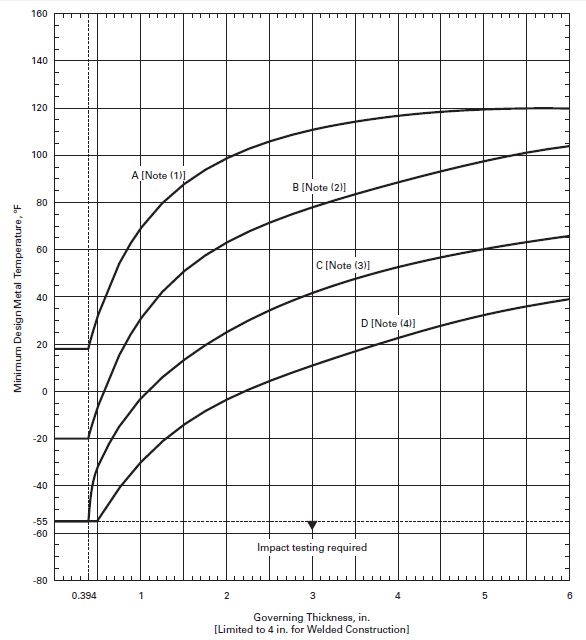
مثلاً در شکل برخورد تلاقی خطوط ضخامت 2 اینچ و دمای 4- روی منحنی D قرار گرفته در نتیجه تافنس تست ضروری نیست.
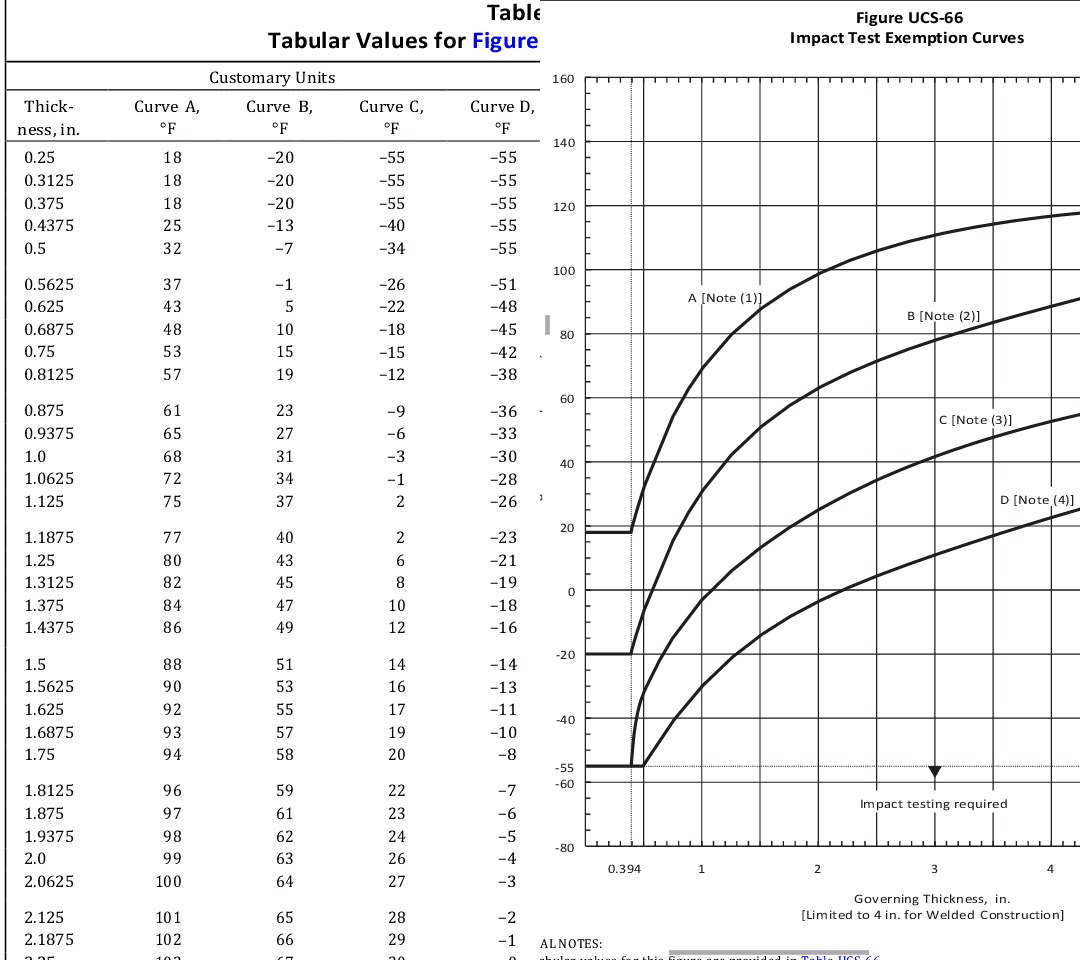
مقادیر داخل جدول UCS-66 معافیت برای قطعات جوش و غیر جوشی طبق توصیف زیر هستند :
- ضخامت حاکم در هر اتصال جوشی متجاوز از ۴ اینچ یا اتصال غیر جوشی بیش از ۶ اینچ و سردتر از ۵۰ درجه سانتیگراد دمای حداقل فلز ( MDMT ) تست ضربه متریال باید انجام شود.
نمونه ای از متریال هایی که در منحنی های مختلف قرار می گیرند :
متریال هایی که در Curve A قرار می گیرند
1) Curve A applies to:
(a) all carbon and all low alloy steel plates, structural shapes, and bars not listed in Curves B, C, and D below;
(b) SA-216 Grades WCB and WCC if normalized and tempered or water‐quenched and tempered;
SA-217 Grade WC6 if normalized and tempered or water‐quenched and tempered.
متریال هایی که در Curve B اعمال می شوند :
(2) Curve B applies to:
(a) see below: SA-216 Grade WCA if normalized and tempered or water‐quenched and tempered
SA-216 Grades WCB and WCC for thicknesses not exceeding 2 in. (50 mm) , if produced to fine grain practice and water‐quenched and tempered
SA-217 Grade WC9 if normalized and tempered
SA-285 Grades A and B
SA-299
SA-414 Grade A
SA-515 Grade 60
SA-516 Grades 65 and 70 if not normalized
SA-612 if not normalized
متریال هایی که در Curve C اعمال می شوند :
3) Curve C applies to:
(a) see below:
SA-182 Grades F21 and F22 if normalized and tempered
SA-302 Grades C and D
SA-336 F21 and F22 if normalized and tempered, or liquid quenched and tempered
SA-387 Grades 21 and 22 if normalized and tempered, or liquid quenched and tempered
SA-516 Grades 55 and 60 if not normalized
SA-533 Types B and C Class 1
SA-662 Grade A
متریال هایی که در داخل منحنی D قرار می گیرند :
(4) Curve D applies to:
SA-203
SA-299 if normalized
SA-508 Grade 1
SA-516 if normalized or quenched and tempered
SA-524 Classes 1 and 2
SA-537 Classes 1, 2, and 3
SA-612 if normalized
SA-662 if normalized
SA-738 Grade A
SA-738 Grade A with Cb and V deliberately added in accordance with the provisions of the material specification, not colder than −20°F (−29°C)
SA-738 Grade B not colder than −20°F (−29°C)
SA/AS 1548 Grades PT430N and PT460N
SA/EN 10028‐2 Grades P235GH, P265GH, P295GH, and P355GH if normalized
SA/EN 10028‐3 Grade P275NH
مرحله بعدی (UCS-66(b ، اگر ضریب ایمنی کمتر از یک باشد ، شکل UCS-66.1 ، مبنایی را برای داشتن MDMT سردتر که از شکل UCS-66a بدون آزمایش ضربه استخراج شده است ، فراهم می کند.
ASME Sec. VIII Div.1: UCS-66(b)
Coincident ratio = tr*E / (tn-c)
Where, tr = Design thickness
E = Joint efficiency
tn = Nominal thickness
c = Corrosion allowance
شکل UCS-66.1 کاهشی در MDMT بدون نیاز ضربه بر مبنای concident ratio فراهم می سازد
مرحله بعد (UCS-66(c ، برای فلنج های زیرین که MDMT سردتر از 29- درجه سانتیگراد ندارند تست ضربه نیاز نیست.
ASME B16.5 flanges of ferric steel
ASME B16.47 flanges of ferric steel
Split loose flanges of SA-216 Gr. WCB as per ASME B16.5 Class 150,300 Carbon and low alloy steel long weld neck flanges
مرحله بعد ( UCS-66(d ، برای متریال های UCS ( منظور کربن استیل ) با ضخامت ۲.۵ میلیمتر و کمتر تست ضربه نیاز نیست اما این چنین متریال های استثناء نباید در دماهای حداقل فلز کمتر از 48- درجه سانتیگراد بکارروند.
برای مخازن یا اجزاء ساخته شده از تیوب های DN 100 یا کمتر یا متریال های P نامبر یک ، معافیت های زیر از آزمایش ضربه نیز به عنوان تابعی از حداقل مقاومت تسلیم مشخص شده متریال (SMYS) برای دمای فلز 105- درجه سانتیگراد و گرمتر مجاز است :

مرحله آخر UCS-68 ، اگر تنش زدایی زمانیکه بطریق دیگری که الزامات این تقسیم نیست انجام پذیرد ، کاهش 17 درجه در دمای معافیت تست ضربه می تواند به دمای حداقل مجاز از شکل UCS-66 برای متریال های P نامبر یک داده شود.
UCS-68 DESIGN
(a) Welded joints shall comply with UW-2(b) when the minimum design metal temperature is colder than −55°F (−48°C), unless the coincident ratio defined in Figure UCS-66.1 is less than 0.35.
(b) Welded joints shall be postweld heat treated in accordance with the requirements of UW-40 when required by other rules of this Division. When the minimum design metal temperature is colder than −55°F (−48°C), and the coincident ratio defined in Figure UCS-66.1 is 0.35 or greater, postweld heat treatment is required, except that this requirement does not apply to the following welded joints, in vessels or vessel parts fabricated of P‐No. 1 materials that are impact tested at the MDMT or colder in accordance with UG-84.
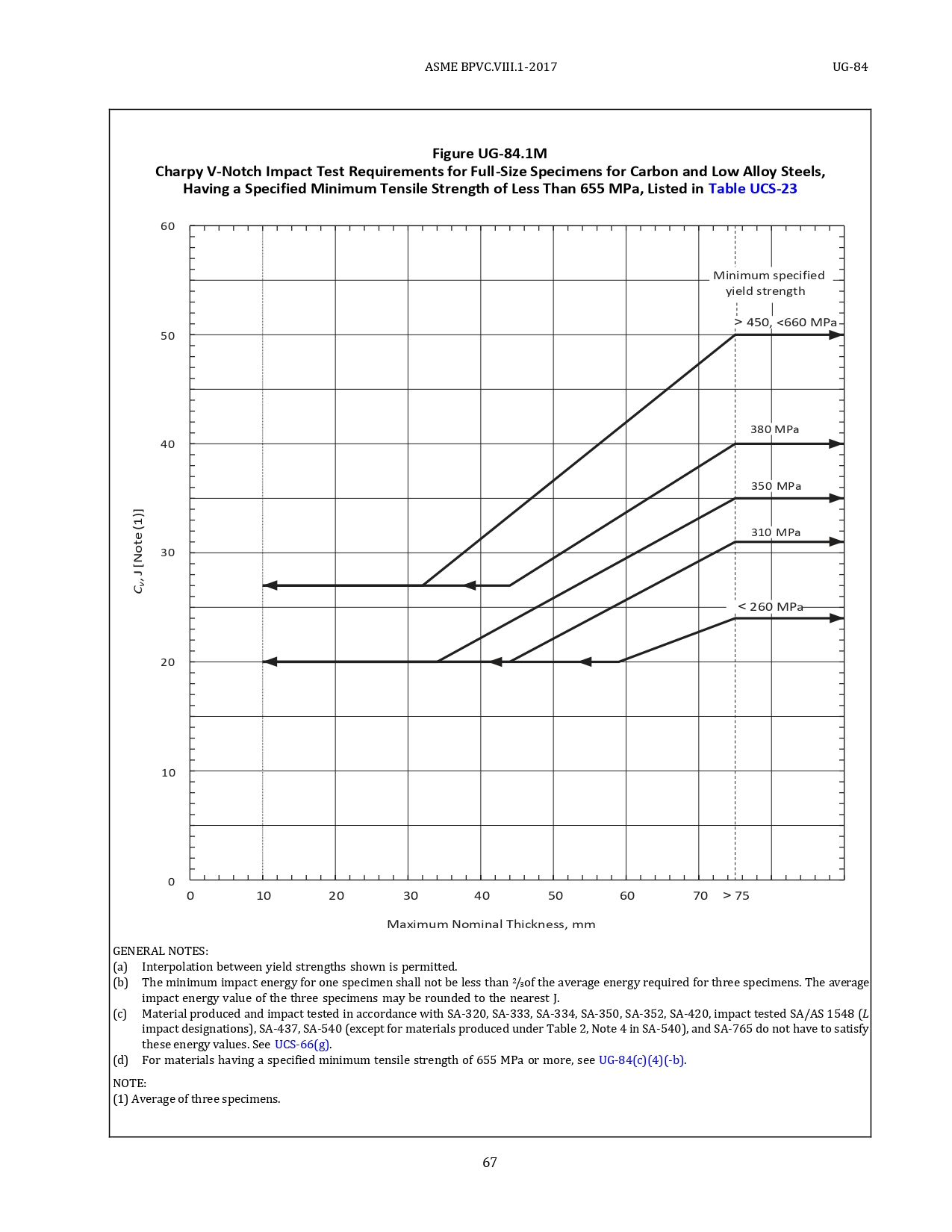
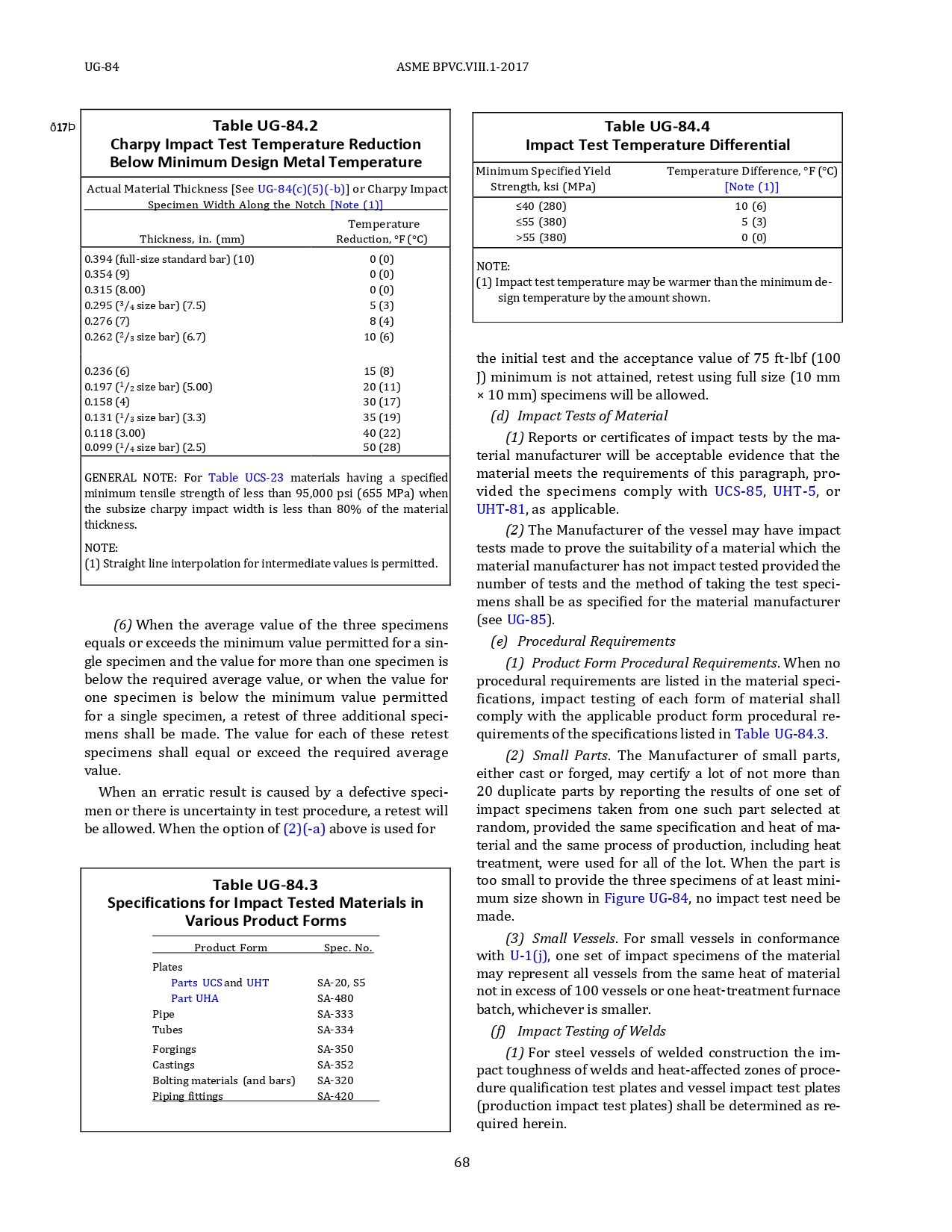
(a) Interpolation between yield strengths shown is permitted.
(b) The minimum impact energy for one specimen shall not be less than 2/3 of the average energy required for three specimens. The average impact energy value of the three specimens may be rounded to the nearest ft‐lb.
(d) For materials having a specified minimum tensile strength of 95 ksi or more, see UG-84(c)(4)(-b).
اندازه نمونه FullSize
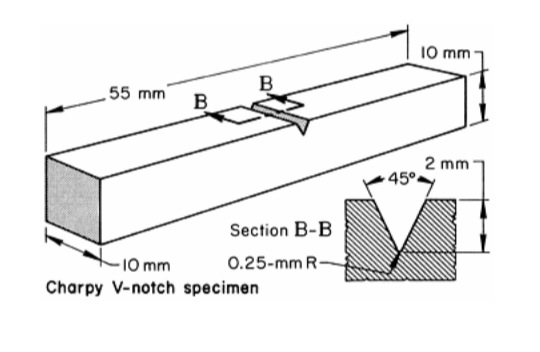
سایز استاندارد نمونه 10mm×10mm است .
تست تافنس برای نمونه 2.5mm نیاز نیست.
برای تمام اندازه های گرفته شده ، حداقل انرژی مورد نیاز با Tensile کمتر از 95000ksi طبق عدد شکل UG-84.1 در نسبت سایز نمونه گرفته شده به سایز استاندارد باید باشد.
The standard (10 mm × 10 mm) specimens, when obtainable, shall be used for nominal thicknesses of 7/16 in. (11 mm) or greater.
Toughness tests are not required where the maximum obtainable Charpy specimen has a width along the notch less than 0.099 in.(2.5mm)
the applicable minimum energy requirement for all specimen sizes for Table UCS-23 materials having a specified minimum tensile strength less than 95, 000 psi (655 MPa) shall be that shown in Figure UG-84.1, multiplied by the ratio of the actual specimen width along the notch to the width of a full‐size (10 mm × 10 mm) specimen
متریال SA-350 LF2 CLASS 1 در دمای 50- درجه فارنهایت تست ضربه انجام می شود . حداقل میانگین انرژی جذب شده برای 3 نمونه آزمون 15ft-lb است ، حداقل انرژی جذب شده 12ft-lb ( میانگین 15 و حداقل 12 ) . حداقل استحکام تسلیم متریال 36ksi است . طبق شکل 84.1 میانگین تست ضربه به 18ft-lb بالاتر میرود بخاطر اینکه متریال از 2 اینچ بیشتر است . حداقل مورد نیاز 2/3 میانگین یا 12ft-lb است ( میانگین 18 و حداقل 12 ).
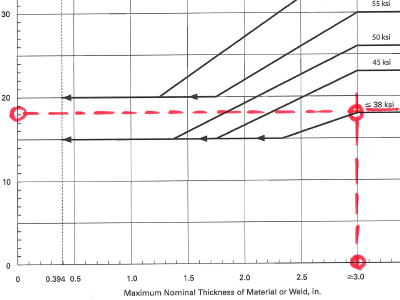
°F to °C : (°F − 32) / 1.8 = °C


























